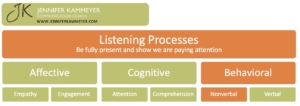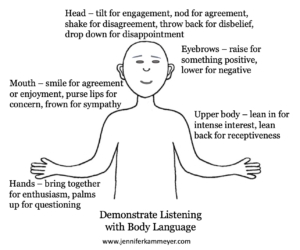Listen with Body Language
Our body language is an important element of listening. Nonverbal communication, commonly called body language, is over 50% of the message we send to others. Research shows that if our spoken words and body language are out of sync, that people will believe what our body communicates, not what we are saying.
We have all been in situations where somebody says they are listening, but we don’t believe them. This is likely because their bodies are not demonstrating listening even though their ears are hearing what we say. We can avoid doing this inattentive listening with others by using our bodies to demonstrate engagement.
In the listening framework we are using to explore the full skill set of listening in 2023, body language falls in the Behavioral category, which addresses how we act as part of the listening process.
Listening with Body Language
Demonstrating listening is mostly done with our head and face, but the upper part of our body can also participate. Here is a break down what we tend to do naturally when we listen. Knowing these elements, we can be intentional in our efforts to demonstrate active listening.
- Head – tilt for engagement, nod for agreement, shake for disagreement, throw back for disbelief, drop down for disappointment
- Eyebrows – raise for something positive, lower for negative
- Mouth – smile to indicate agreement or enjoyment, purse lips for concern, frown for sympathy
- Upper body – lean in for intense interest, lean back for receptiveness
- Hands – bring together for enthusiasm, palms up for disbelief
All of these elements happen in conjunction with one another depending on the expression. A reaction to somebody telling us their boss just called them out for something minor in a meeting could be: nodding with a furrowed brow and pursed lips, then throwing our head back and bringing open palms up in disbelief.
Practice: Listen with Body Language
This month when we listen to people tell stories about their day, we can notice how our bodies are demonstrating listening and intentionally adjust.
- Notice what we naturally do with our head, face, upper body, and hands when we listen
- Experiment with intentionally using one part of our body to demonstrate we are listening
- Note how it feels and note the other person’s reaction
The sense we get that somebody is listening to us comes from the nonverbal communication message they send with their body. So, we can intentionally use body language that demonstrates listening to others and give people that wonderful sense of being heard.


